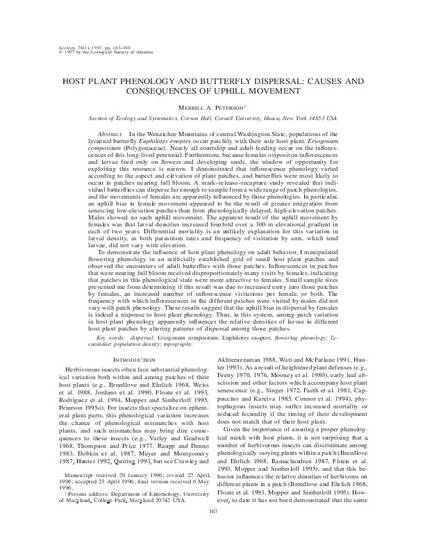
- Dispersal,
- Eriogonum compositum,
- Euphilotes enoptes,
- Flowering phenology,
- Lycaenidae,
- Population density,
- Topography.
- Biology and
- Entomology
In the Wenatchee Mountains of central Washington State, populations of the lycaenid butterfly Euphilotes enoptes occur patchily with their sole host plant, Eriogonum compositum (Polygonaceae). Nearly all courtship and adult feeding occur on the inflorescences of this long-lived perennial. Furthermore, because females oviposit on inflorescences and larvae feed only on flowers and developing seeds, the window of opportunity for exploiting this resource is narrow. I demonstrated that inflorescence phenology varied according to the aspect and elevation of plant patches, and butterflies were most likely to occur in patches nearing full bloom. A mark–release–recapture study revealed that individual butterflies can disperse far enough to sample from a wide range of patch phenologies, and the movements of females are apparently influenced by those phenologies. In particular, an uphill bias in female movement appeared to be the result of greater emigration from senescing low-elevation patches than from phenologically delayed, high-elevation patches. Males showed no such uphill movement. The apparent result of the uphill movement by females was that larval densities increased fourfold over a 300-m elevational gradient in each of two years. Differential mortality is an unlikely explanation for this variation in larval density, as both parasitism rates and frequency of visitation by ants, which tend larvae, did not vary with elevation. To demonstrate the influence of host plant phenology on adult behavior, I manipulated flowering phenology in an artificially established grid of small host plant patches and observed the encounters of adult butterflies with those patches. Inflorescences in patches that were nearing full bloom received disproportionately many visits by females, indicating that patches in this phenological state were more attractive to females. Small sample sizes prevented me from determining if this result was due to increased entry into those patches by females, an increased number of inflorescence visitations per female, or both. The frequency with which inflorescences in the different patches were visited by males did not vary with patch phenology. These results suggest that the uphill bias in dispersal by females is indeed a response to host plant phenology. Thus, in this system, among-patch variation in host plant phenology apparently influences the relative densities of larvae in different host plant patches by altering patterns of dispersal among those patches.
Available at: http://works.bepress.com/merrill_peterson/4/
